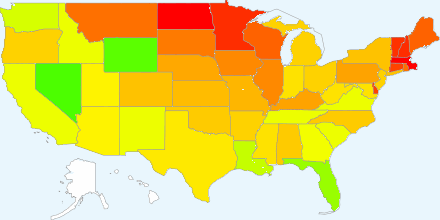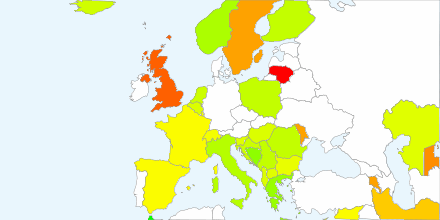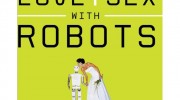

Question: Would you consider role-playing out a rape fantasy with partner who asked you to? 340,000 people responded. Green = YES, Red = NO.
It’s a very specialized kind of porn. It’s my kind of porn. It’s data mining porn!
Recently (in June) and with little fanfare to the world outside, popular dating site OKCupid, the venerable hookup hotspot, launched the OKCupid Trends Blog. Here, they keep me endlessly fascinated with their humorous presentation of data used to discover trends and statistics from their users. Which, by the way, are a lot of people. Especially when you consider that over 300,000 people answered an OKCupid poll, while 3050 answered a nationwide Gallup poll for the 2008 American election. (Yay old media. Not.)
You know they’ve got *tons* of data on users and it’s got to be worth a pile of money — not to mention how much value could be gleaned about learning people’s actual sexual and dating habits. They feel that way too. What they’re analyzing is also really helpful information for online dating. And importantly, I appreciated that they address privacy issues up front and explain how they’re anonymizing the information. Caveat: it’s mostly heterosexually focused but they are listening to users and have started offering same-sex dating data presented as tips.
Favorites include Online Dating Advice: Same-Sex Messaging (what words do and don’t work in messages to women and men), Online Dating Advice Part 1 (very useful), Sweet-ass American Trends (great map post, including Rape-Fantasies and Hygiene By State), Flowchart To My Heart, and the real must-read, Online Dating Advice: Exactly What To Say In A First Message. (thanks, Z!)



@ violet: Glad it was helpful! We need good statistics on sex and kinky people! Love the blog!
@ Anon-upon-Moron: As I said about Gallup – “Gallup’s methodology might not be always top notch”. Sampling people randomly is hard and no polling firm has yet been able to deal with the fact that more and more people don’t have landline phones. A selection bias is always possible. Some polling firms have statistical models to compensate for this, others don’t. The demographic data can always be compared to census data about the general population to get an idea of if a poll’s sample is reflective of the general population (or a specific subset).
Either way, I’m left with an image of Gallup calling several thousand of random households and asking the respondent if they’d play out a rape fantasy, and that mental image is priceless!
I’d think that in general (het)women would be more willing to play out their partner’s rape fantasy than (het)men because playing the victim doesn’t really make her look like a freak. Whereas if a woman asks a man to play a rapist, he wouldn’t want to seem too eager, you know? If you get all bright eyed and bushy tailed and exclaim “That sounds like a great idea!” your girl’s going to think she’s dating Ted Bundy, so it would probably be better to act conflicted about it. “Rape? Oh dear, I don’t know if I could play something that horrifying… But if you really want me to, I’ll do it for you, baby.” But I don’t have a theory on which states would have the biggest gender difference.
@t in pdx, Galup polls are not that random, there is almost always some selection bias. Often the respondents are telephoned, and so they tend to favor people who have nowhere to go around 7-8 pm, but still answer the phone during dinner.
Not that the OKCupid polls is are great statistics. I think the question “Would you consider role-playing out a rape fantasy with partner who asked you to?” is confusing, or at least my “no” answer would be confusing. Maybe they should have had a box for “No, I would not need to consider it, or know who is being play-raped. My answer is a resounding “YES” without hesitation or consideration.” However that answer would be difficult to represent on their continuum.
@t in pdx: thank you for that information; that isn’t something most of us would know. it’s really helpful (though I still am not a fan of Gallup!) and @Alex: now I really really want to see the gender breakdown. I mean, it seems to me that if it’s weighted in one direction or the other, regardless of which gender is higher in interest, it’s bound to be somewhat shocking.
I wonder how that rape fantasy map would look if you broke it down by gender.
“300,000 people answered an OKCupid poll, while 3050 answered a nationwide Gallup poll for the 2008 American election. (Yay old media. Not.)”
Yay old media, yes and no. Gallup’s methodology might not be always top notch, but given the right statistical sampling techniques a random sample of 3000 people might give you better results then a self selected group of 300,000. The results of a self select sample are inherently biased because it isn’t randomized. A truly randomized sample gives you much greater statistical power. If you dig into most polls, like Gallup, you can get their cross-tabulations with corresponding p-values. P-values of will tell you the likelihood that a given result is due to random chance. Please, please, please don’t be sloppy with statistics!
Still, great post!